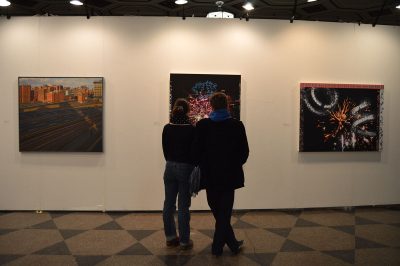Every year, the Boston University College of Fine Arts School of Visual Arts presents its MFA Thesis Shows, where second-year graduate students showcase their work in graphic design, painting and sculpture.

The 2021 design show featured 17 2021 MFA graphic design candidates in an exhibit titled “The Printer is Broken” — using “an unreliable tool as a framing metaphor,” according to the school’s website.
The exhibit — which emphasized collaboration and explored themes such as uncertainty and resilience — recently completed its run from March 26 through Tuesday at the Stone Gallery.
While the graphic design portion of the 2021 exhibition is over, the painting section begins April 15.
Four students reflected on their experience with the exhibit and its unique collaborative spirit after a year of physical distance.
Byori Hwang, a 2021 MFA graphic design candidate and an artist in the exhibit, said she struggled tackling her final semester at BU, given the pandemic.
“It was very very tough,” she said. “I personally struggle with online classes, and then for art and design, I think it’s better to study in classrooms.”
In spite of the difficulty, Hwang said she was also grateful to have the exhibition in person.
“It’s a little bit better than previous years because last year, the second year students weren’t able to make the physical exhibition show,” she said. “This year we had a chance.”
Hwang said the exhibit is usually finished in May, but was completed earlier this year. She said though this made it “tough,” seeing the physical designs made it worth it.
Michael Rosenberg, another student and artist in the exhibit, also said he struggled planning the exhibition over Zoom, as well as having less time than usual to prepare. He added that the COVID-19 testing site at 808 Commonwealth Ave. was formally a gallery location, which caused the group to adjust.
“A lot of us were kind of worried because we wouldn’t have our thesis ready so what would we want to show,” he said. “That’s why we adapted and showed work from our own library and stuff as well.”
Rosenberg said his favorite part of the exhibition was the collaborative themed wall. He said the group used the process colors from printers to create an overlaid collage of their posters with vivid colors, creating magenta, green and orange, for example.
“The overlay created interesting compositions with each of the works that were put in, so all of the work of our year kind of became its own art piece,” he said. “It was this beautiful metaphor also for this exhibition in a way, all of these individual people coming together to make one thing.”
The end result was a print 80 inches tall and 130 inches wide, Rosenberg said. It’s also a testament to the “super collaborative” nature of the exhibit, he added.
Arielle Epstein, another student featured in the exhibit, said she too enjoyed the collaborative process.
“Something that was really unique to the show was the fact that it was the first time we had really displayed our work as a more collaborative piece,” she said. “Everything was mixed together, there was a lot more digital, there were two projection screens and … a website.”
The website also had a virtual walkthrough to allow the community at large to view the works, she said.
Epstein added that while the collaborative wall may have looked disorganized at first glance, it was quite the opposite.
“[The posters] were all kind of overlapping and put on this grid, that at first glance looked like it had no organization to it, but it was actually very carefully laid out,” she said. “My pieces, which were these monsters … they were all spread out throughout it, making it feel like this cohesive mural.”
Sohini Mukherjee, a student and featured artist in the exhibit, said the cooperative nature of the project changed the way she looks at viewing art.
“For me, viewing art or a show, which showcases other people’s art, it’s like, there has to be a name tag, there has to be a specific designated space for that person,” she said, “but this idea completely changed my mindset on that because it’s so collaborative so it’s not about you, it’s more about the collective.”
Mukherjee said seeing the exhibit in person was her favorite part of the experience and a special opportunity.
“We all miss that human touch,” she said. “I really enjoyed that seeing people in person and my classmates because we hadn’t seen each other since like last spring, so it was definitely very nostalgic.”
























































































































KS • Apr 7, 2021 at 6:29 pm
Here’s a link to the exhibition website: https://theprinterisbroken.com/
Great work, MFA GD 2021!